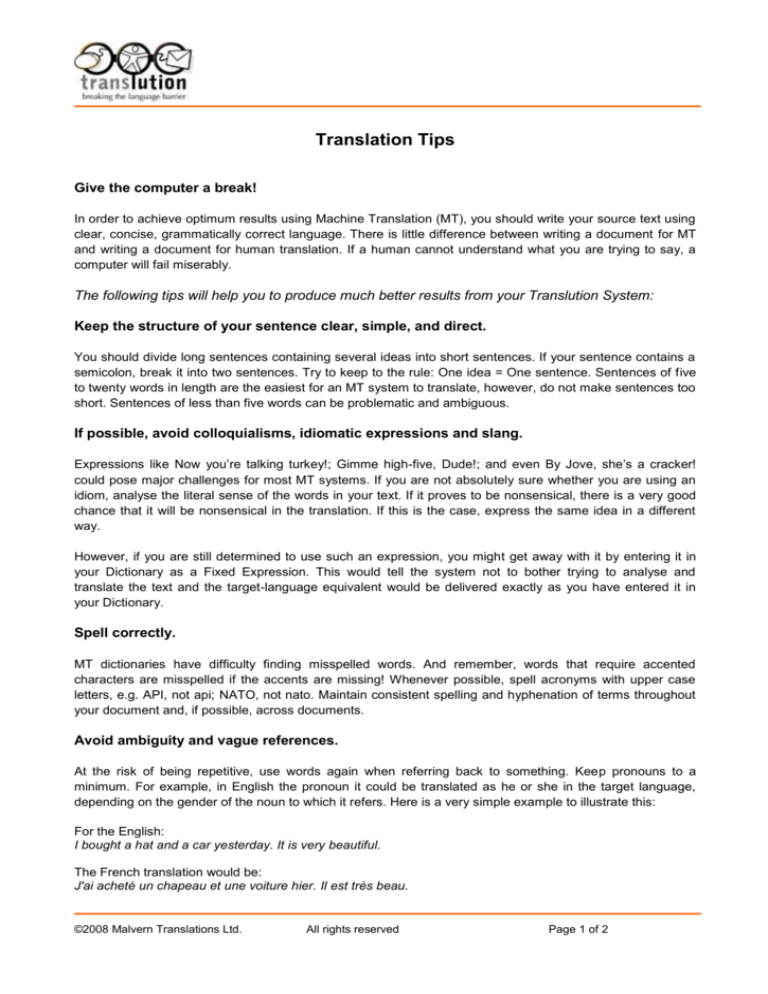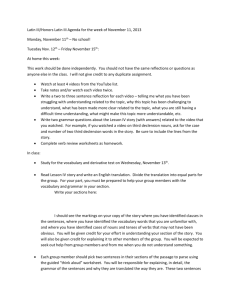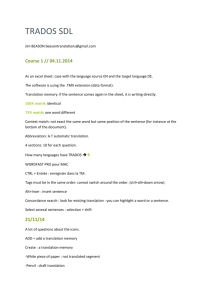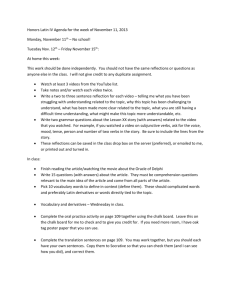
Translation Tips
Give the computer a break!
In order to achieve optimum results using Machine Translation (MT), you should write your source text using
clear, concise, grammatically correct language. There is little difference between writing a document for MT
and writing a document for human translation. If a human cannot understand what you are trying to say, a
computer will fail miserably.
The following tips will help you to produce much better results from your Translution System:
Keep the structure of your sentence clear, simple, and direct.
You should divide long sentences containing several ideas into short sentences. If your sentence contains a
semicolon, break it into two sentences. Try to keep to the rule: One idea = One sentence. Sentences of five
to twenty words in length are the easiest for an MT system to translate, however, do not make sentences too
short. Sentences of less than five words can be problematic and ambiguous.
If possible, avoid colloquialisms, idiomatic expressions and slang.
Expressions like Now you’re talking turkey!; Gimme high-five, Dude!; and even By Jove, she’s a cracker!
could pose major challenges for most MT systems. If you are not absolutely sure whether you are using an
idiom, analyse the literal sense of the words in your text. If it proves to be nonsensical, there is a very good
chance that it will be nonsensical in the translation. If this is the case, express the same idea in a different
way.
However, if you are still determined to use such an expression, you might get away with it by entering it in
your Dictionary as a Fixed Expression. This would tell the system not to bother trying to analyse and
translate the text and the target-language equivalent would be delivered exactly as you have entered it in
your Dictionary.
Spell correctly.
MT dictionaries have difficulty finding misspelled words. And remember, words that require accented
characters are misspelled if the accents are missing! Whenever possible, spell acronyms with upper case
letters, e.g. API, not api; NATO, not nato. Maintain consistent spelling and hyphenation of terms throughout
your document and, if possible, across documents.
Avoid ambiguity and vague references.
At the risk of being repetitive, use words again when referring back to something. Keep pronouns to a
minimum. For example, in English the pronoun it could be translated as he or she in the target language,
depending on the gender of the noun to which it refers. Here is a very simple example to illustrate this:
For the English:
I bought a hat and a car yesterday. It is very beautiful.
The French translation would be:
J'ai acheté un chapeau et une voiture hier. Il est très beau.
©2008 Malvern Translations Ltd.
All rights reserved
Page 1 of 2
The MT System has a problem working out whether it refers to hat or car. You may be very clear that it refers
to the car and not the hat, but anyone else would have to guess, and computers are no more clairvoyant
than people are. In this example, the system has delivered a masculine pronoun, rather than the correct,
feminine, pronoun.
Repeating the noun in question:
I bought a hat and a car yesterday. The car is very beautiful.
results in a perfectly accurate French translation:
J'ai acheté un chapeau et une voiture hier. La voiture est très belle.
When listing or enumerating, repeat the noun being modified, Take the red, green and yellow apples will
probably not be translated correctly. Take the red apples, green apples and yellow apples will almost
certainly be translated correctly.
Use standard, formal language.
Clear, formal, grammatically correct writing is easiest for a reader to understand. Clear, formal, grammatically
correct writing is easiest for an MT system to understand. Make sure your verbs agree in number with the
subject. Correct punctuation will help as well. If you want your emails translated correctly, you may well need
to change your writing habits.
Use the definite article even when you don‘t want to.
When an MT system analyses English it is often difficult for the system to distinguish between verbs and
nouns. Most short nouns can be verbs as well, e.g. bank, log, lodge.
Instructions often tend to omit definite articles, for example:
This
would be better like this
Twist cap off
Remove seal
Insert applicator
Twist the cap off
Remove the seal
Insert the applicator
Summary
All the above tips will help you achieve improved quality in your translations. However, remember that the
most important tool to improve quality is your Translution Dictionary. Use your Dictionary Manager to build up
your own personal terminology. This will correct any errors that the MT system may make in translating
terms.
©2008 Malvern Translations Ltd.
All rights reserved
Page 2 of 2












